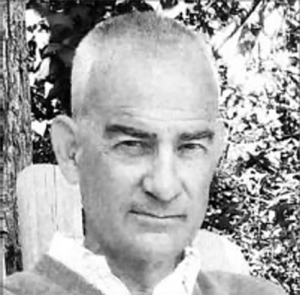
John Adams
John Adams of Andover and Lincoln died on October 7 of Parkinson’s disease and Lewy body dementia at the age of 79. A direct descendant of John Adams and John Quincy Adams, he maintained strong ties to the Adams Historical Site in Quincy, often giving talks about important events in the Adams’ lives.
John was born on April 13, 1941, eight months before the Japanese bombed Pearl Harbor. Due to the war, his early childhood was spent on various army bases where his father, Thomas Boylston Adams, a Boston Globe columnist for many years, served as a gunnery instructor, teaching young men to shoot down fighter planes from B-17 and B-24 bombers. John was the oldest of five children and grew up in Lincoln, where his father, grandfather, and great-grandfather had also grown up.
In many ways his family resembled a typical Boston upper class family of the ’50s and ’60s: prestigious clubs, private schools, frequent entertaining, and travel abroad. But his parents put a significant twist on this pattern by privileging and promoting artistic and cultural achievement in their guests and the lives of their children. John’s mother, Ramelle Cochrane Adams, was an accomplished pianist and the house was often filled with the sounds of children practicing or impromptu concerts. A trip to France was organized around a pilgrimage to the great cathedrals where the children were taken to high mass to experience the power of music in the vast spaces and were then later tasked with drawing a stained glass window or writing their impressions in their sketchbooks.
John spent every summer from the age of seven at a family compound on the South Shore called the Glades Club. There he was a leader of a tribe of children and shared all the sports passions of the time: swimming, diving, spearfishing, sailing, tennis, softball, model making, charades, beckon and magic glove. Forecasting what would become his obsession with naval history, John led his cousins in assembling from kits a fleet of battery-operated warships. The group deployed them in dramatic battles in Glades puddles, culminating in their destruction by cherry bombs.
The usual educational paths for an Adams at this historical point were either the fields of the humanities or finance. Science or technology was a discipline the Adamses respected but definitely considered alien to their family culture. Nevertheless, John’s style of thinking did not lend itself to areas of gray. He liked to use his intense focus to solve complex problems with a definitive outcome. And so he majored in math at Harvard and then, by 1974, achieved master’s and PhD degrees in structural engineering from Tufts and MIT, respectively.
His special insight at this time was seeing the possibilities of the computer as it applied to the practice of engineering. In 1965, the computer was in its infancy and its power to solve real world problems was just beginning to be realized. At this pivotal moment, by chance, John was given the opportunity to run the computer center at Tufts and thus gained so many insights about its application to engineering that he taught a course using the computer to design the structures of buildings. He was thrilled to note his professors sitting in the back row of his classroom. It was when he was at Tufts in 1966 that he met Patricia Jones, a fellow Harvard student from West Hartford, Conn., to whom he was married for 53 years.
In 1972, after the birth of their first son, Sam Adams, John and Patty bought a big old house with John’s brother Peter Adams and his wife Sherry on the Higginson estate just up the hill from his parents’ house in Lincoln. Another brother, Douglas Adams and his wife Trish, built a house across the pond from this house, thus forming a kind of informal Adams enclave. John and Patty’s second son, Darcy Adams, was born in 1977. These families lived abutting each others’ very spacious back yards, raising their children together for 20 years. The Adams parents continued to be the glue holding the family together, planning the special rituals of holiday celebrations, Sunday teas, and dinner parties often followed by Shakespeare readings, waltz evenings or a lecture at the Massachusetts Historical Society.
All his life, John never stopped being the paradigmatic oldest child. He was caretaker and teacher to his siblings and children, enthusiastic cheerleader and supporter of his wife, and later mentor and leader of the large groups of engineers building complex products and over whose careers he watched. He had a huge impact on the lives and careers of many people. He was respected and loved by people around the world. He gave workers confidence by seriously listening to their opinions. He helped employees see the unique value they added to the team, giving them visions of themselves that built on their uniqueness. His openness to new ideas made controversial issues discussable and fostered a safe space in which to be honest and direct. The nature of his job was to let others speak and thereby foster the technical development of the group. But he allowed himself to show his deep technical prowess when presenting the products his groups designed. Customers sat spellbound listening to his visions of how they could transform the way they did business using his products.
John often led by example. In a fast-paced and competitive environment, first at Digital Equipment Corp. (1976-1996) and later at RSA Security (1996-2001), John urged his team to put family first. He had large pictures of his wife and sons all over his office and rarely missed an important event in their lives. He inspired his group to keep family foremost in their thoughts.
In terms of professional accomplishments, John was especially proud of his contributions bringing the pioneering Ethernet LAN technology to market while at Digital. He was also proud of being an integral part of the acquisition of RSA Data Security when he worked for Security Dynamics. His vision for their integration into RSA Security helped set the tone for the merged companies, ultimately creating one of the most recognized names in cybersecurity.
In addition to his beloved wife Patricia Adams, his beloved sons Darcy Adams and Sam Adams, and his cherished daughters-in-law Lena Adams and Courtney Adams, he also leaves his adored granddaughters Quincy Adams, Mary Adams, Lucy Adams, Georgia Adams, and Jane Adams. He leaves his much-loved brothers Douglas Adams and Henry Adams, beloved sister Ramelle Adams, sisters-in-law Patricia Ingersoll Adams, Marianne Adams and Sherry Adams, and brother-in-law Jeffery Lukowski. John was predeceased by his brother, Peter Boylston Adams. There will be a private service in celebration of John’s life this summer.
Condolences and memories may be left on Legacy.com.






